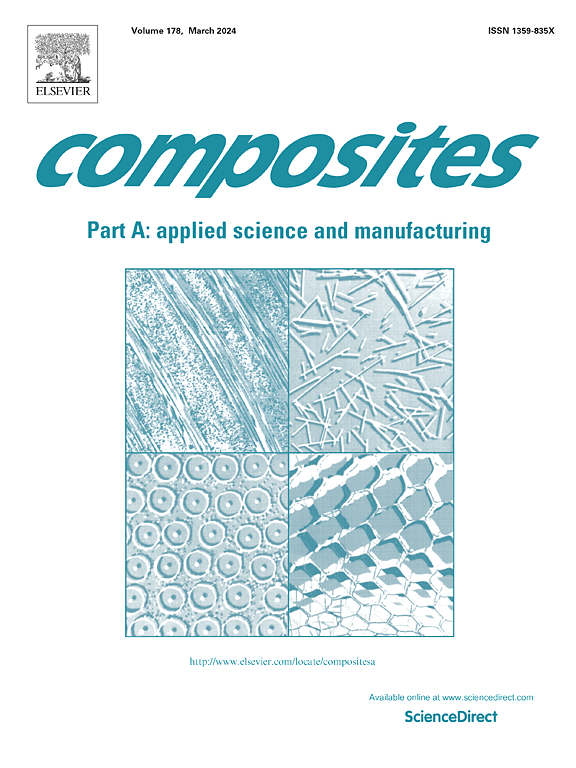Vibration-Assisted Thermal Repairing (VATR) of thermoplastic composites
IF 8.1
2区 材料科学
Q1 ENGINEERING, MANUFACTURING
Composites Part A: Applied Science and Manufacturing
Pub Date : 2025-04-19
DOI:10.1016/j.compositesa.2025.108928
引用次数: 0
Abstract
Repairing composite structures is crucial for extending their service life, and there is an increasing need for repair techniques compatible with thermoplastic composites (TPCs). As the significance of welding TPC joints grows, evaluating their repairability becomes essential. Therefore, this study focuses on developing an innovative method called vibration-assisted thermal repairing (VATR) for matrix repairing of carbon fiber/polyetheretherketone (CF/PEEK) thermoplastic joints by inserting an amorphous polyetherimide (PEI) resin at the interface of two CF/PEEK substrates. In this regard, initially, a four-layer CF/PEEK laminate was manufactured using Automated Fiber Placement (AFP). The CF/PEEK specimens were then stacked with an amorphous PEI layer inserted between them and welded at 310 °C under a constant pressure using two methods: traditional thermal repairing and vibration-assisted thermal repairing. To study the feasibility of VATR technique, a custom experimental setup was designed and built to enable controlled thermal welding, with and without the application of vibration. The effects of frequency and time on the lap shear strength and void content were then compared for both repair methods. Additionally, interface zone mapping was employed using a pseudo-coloring method to analyze the effect of vibration on polymer chain diffusion. Results from the VATR method revealed a stronger and more uniform repair interface, with greater diffusion of PEI in the parental CF/PEEK substrates compared to traditional thermal repairing. Overall, this new repair method demonstrated significant potential for TPC joint repair, showing a 22% improvement in shear strength and a 35% reduction in void content.
热塑性复合材料的振动辅助热修复(VATR)
复合材料结构的修复对于延长其使用寿命至关重要,因此对与热塑性复合材料(TPC)兼容的修复技术的需求与日俱增。随着热塑性复合材料焊接接头的重要性日益增加,对其可修复性进行评估变得至关重要。因此,本研究重点开发了一种称为振动辅助热修复(VATR)的创新方法,通过在两个 CF/PEEK 基材的界面上插入无定形聚醚酰亚胺(PEI)树脂,对碳纤维/聚醚醚酮(CF/PEEK)热塑性接头进行基体修复。在这方面,首先使用自动纤维铺放(AFP)技术制造了四层 CF/PEEK 层压板。然后将 CF/PEEK 试样堆叠起来,在它们之间插入无定形 PEI 层,并在 310 °C 的恒压条件下使用两种方法进行焊接:传统热修复和振动辅助热修复。为了研究 VATR 技术的可行性,我们设计并制作了一个定制实验装置,以便在有振动和无振动的情况下实现受控热焊接。然后比较了两种修复方法的频率和时间对搭接剪切强度和空隙含量的影响。此外,还使用伪着色法绘制了界面区图,以分析振动对聚合物链扩散的影响。VATR 方法的结果表明,与传统的热修复方法相比,修复界面更坚固、更均匀,PEI 在母体 CF/PEEK 基材中的扩散也更大。总体而言,这种新的修复方法在 TPC 接头修复方面表现出了巨大的潜力,其剪切强度提高了 22%,空隙含量减少了 35%。
本文章由计算机程序翻译,如有差异,请以英文原文为准。
求助全文
约1分钟内获得全文
求助全文
来源期刊

Composites Part A: Applied Science and Manufacturing
工程技术-材料科学:复合
CiteScore
15.20
自引率
5.70%
发文量
492
审稿时长
30 days
期刊介绍:
Composites Part A: Applied Science and Manufacturing is a comprehensive journal that publishes original research papers, review articles, case studies, short communications, and letters covering various aspects of composite materials science and technology. This includes fibrous and particulate reinforcements in polymeric, metallic, and ceramic matrices, as well as 'natural' composites like wood and biological materials. The journal addresses topics such as properties, design, and manufacture of reinforcing fibers and particles, novel architectures and concepts, multifunctional composites, advancements in fabrication and processing, manufacturing science, process modeling, experimental mechanics, microstructural characterization, interfaces, prediction and measurement of mechanical, physical, and chemical behavior, and performance in service. Additionally, articles on economic and commercial aspects, design, and case studies are welcomed. All submissions undergo rigorous peer review to ensure they contribute significantly and innovatively, maintaining high standards for content and presentation. The editorial team aims to expedite the review process for prompt publication.
 求助内容:
求助内容: 应助结果提醒方式:
应助结果提醒方式:


